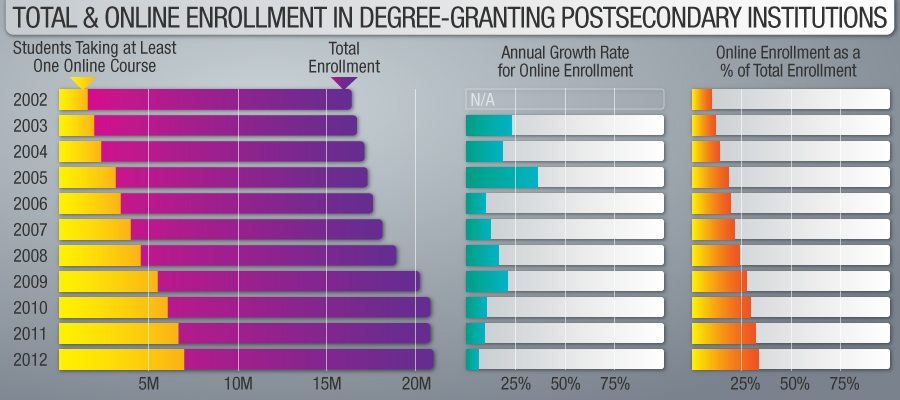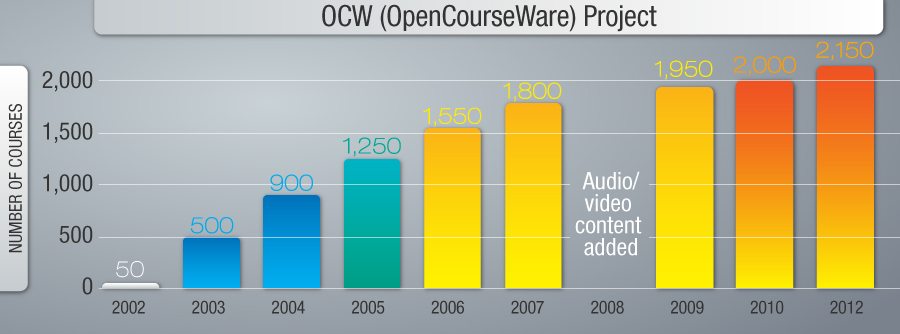Unless you avoid the Internet like a plague, you’ve probably noticed ads for online degrees on many Web sites. They’re even in TV commercials. While the option to take college degree courses online has been around for many years, being able to take an entire degree online is a relatively newer phenomenon.
It’s new enough, in fact, that the U.S. Dept of Education only started requiring student enrollment numbers for both online courses and online degrees as of Fall 2012. Prior to that, reporting such data was optional and inconsistent, sometimes with duplication of enrollment counts for single online courses. For online degrees, the data is scarcer still, and post-2012 numbers have yet to be published by the Dept of Ed (at time of writing).
That said, one thing that existing data shows is that there is an increasing number of traditional brick-and-mortar universities and colleges offering undergraduate and/or graduate degrees with the option to complete them entirely online. The smaller non-profit universities and colleges, especially the private ones, seem to have the advantage in number of online degrees offered, but it is a growing trend across all schools. Some start by offering a selection of courses online, and if the enrollment numbers warrant it, later create and offer entire degree programs online.
Here, we cover the some of the data available for both online course and online degree enrollment. Check out U.S. News’ list of “Best Online Bachelor’s Programs” for a more comprehensive look at specific online bachelor’s degrees around the world. Completing a college degree remotely is not a new concept. In the U.S., in the 1700s at a Boston college, one program allowed students to finish their degrees by mail.
Non-Classroom Courses in History
Further back in history, one of the oldest medical schools in the world, University of St. Andrews in Scotland, initially granted an MD (medical degree) through the mail, from 1696 through part of the 1800s. A candidate with an existing medical practice would mail a fee, along with a signed testimonial from a supervisor.
These are just a few examples of distance education in the past. Arguably, this approach to completing degrees got its biggest boost from the Internet and portable/ mobile computing (laptop, smartphone, tablet), which have made it easier over all for students en masse to complete degrees without ever setting foot on a campus. With this technology, it’s:
• Easier for educators to deliver course content to remote students, especially multimedia.
• Easier for students to access content (central course repositories).
• More options for consuming content, especially in digital form. E.g., on tablets and other mobile devices.)
• Easier for students to solicit explanations from professors and teaching assistants (email, discussion boards/ /forums, social media, virtual worlds such as Second Life). This is especially important for the shy students afraid to ask questions in real classrooms.
• Easier for students to discuss topics with each other (email, discussion boards/ forums, social media)
• Easier for students to collaborate on projects.
• Easier for students to submit assignments and other work.
• Easier for educators to collect student work and digitally monitor results.
• Easier for students to schedule courses — especially those that are prerequisites for later courses — with less likelihood of time conflict or over-enrollment and waiting lists.
• Easier on students, time-wise, who have other obligations (job, family), as they have greater flexibility to consume course content.
• Potentially lower costs, such as reduced transportation, vehicle, gas costs, residence costs, certain campus fees, etc.
The list goes on.
Are Brick-and-Mortar Schools Becoming Obsolete?
This might lead some people to wonder if we even need in-classroom courses and degree programs anymore. Of course, there are multiple benefits to brick-and-mortar colleges and universities. A few are:
• The option of multi-sense instruction. That is, on-campus courses offer potentially more variety to suit learning styles. Some people prefer to learn by listening (auditory) to a lecturer. Others prefer to read (visual) either notes on a blackboard or overhead screen. Still others prefer to be shown (tactile/ kinesthetic), such as in a lab. Online courses may lack some of these options.
• Absorption of topics through a live class, in sequential bites in the form of slides or blackboard, plus interaction with the lecturer, for questions. This, of course, is the gist of the proposed value of on-campus degree programs, and is especially important for “foundation” courses which may be introducing new concepts to a larger number of students but are a degree requirement to continue.
• The opportunity of getting access to a specific professor one on one.
• Face-to-face interaction with teaching assistants.
• Face-to-face interaction with classmates, for study sessions and project collaboration.
• Physical library, with access to books and other material for free that may not be available online.
• Social clubs, campus events, etc., to punctuate intense periods of study with relaxed interaction with fellow students.
• General face-to-face interaction with fellow students, which helps form strong social bonds that can continue past college in many ways (friendship, marriage, business partnership).
In general, human feedback, encouragement and/or validation are important benefits of on-campus study that can motivate students. That said, not every student needs or wants these benefits, evidenced by the growth in the U.S. of online courses and full online degree programs. Some of these courses are optional, others are compulsory, making for hybrid degrees that have both on-campus and online instruction. Increasing numbers of entirely online degree offerings are not just from “online universities,” but also from brick-and-mortar colleges and universities who traditionally have offered all courses on-campus only. Here are several education metrics that have increased in recent years:
• Number of students taking online courses
• Number of online courses
• Number of educational institutions offering online courses
• Number of online degree programs
Here are some figures from the Online Learning Survey (OLS) yearly reports by the Babson Group/ Sloan Consortium. Caveat: as mentioned earlier, the U.S. Dept of Education did not require colleges and universities to report some of these figures until 2012, so they differ from the OLS numbers, some of which have presumably been extrapolated from available data. The OLS data is compiled from the responses of between 2,500-2,800 American colleges and universities over the years listed. For some schools, the OLS data is more accurate than Dept of Ed data, but not always. The data does not differentiate between students taking at least one online course and those taking their entire degree online.

The gist of this data is that the percentage of students in U.S. colleges and universities who take one or more online courses each academic year is increasing steadily. As well, surveyed academic leaders at such institutions are growing in number for those who feel online education is the same or better than for face-to-face instruction — from 57% in 2003 to 77% in 2012. Prior to that, online degree instruction was not as much of a priority for many schools, apparently because many academic leaders did not feel the quality was the same as for traditional on-campus instruction.
Modern Day Distance Learning
Now, it’s estimated that over 50% of American four-year colleges and universities offer one or more fully online degree programs, including master’s and doctoral degrees. In fact, some schools favor graduate degrees being fully online over undergraduate degrees.
One example of an online MBA program is from Indiana University’s Kelley School of Business, launched in 1999, at a time when mostly for-profits schools like University of Phoenix were doing so. Now (as of Apr 2014) this program has over 1,000 students enrolled — more than double the enrollment for Kelley’s regular on-campus two-year program. As for tuition, for online students the two-year cost is just over $61K ($61.2K), while regular on-campus students pay $93K for the same period.
Similarly, there are 551 students in UNC Chapel Hill’s online MBA (Kenan-Flagler Business School), which is more than for its regular program. Once again, online tuition is cheaper at just over $96K compared to just over $111K for on-campus instruction.
Kelley and Kenan-Flagler were the only 2 of 20 B-schools listed in Bloomberg Businessweek’s biannual ranking, though that’s likely to change — at least for the B-schools which are not top-ranked. There are a total of 420 U.S. MBA programs are accredited by AACSB (Association to Advance Collegiate Schools of Business). UC Berkeley’s dean of the Haas School of Business, Richard Lyons, is quoted in Businessweek saying, “Half of the business schools in this country could be out of business in 10 years — or 5.” His implication is that that’s if traditional schools do not adapt and offer more online programs.
Interest in MBA programs is already declining. GMAT (Graduate Management Admission Test) applications for entering an MBA program had a 6% drop from 2002, down to about 117K American citizens applying in by Jun 30, 2012 (for Fall 2013). Nearly half (46%) of all American MBA programs had a decline in 2013 applications. The biggest threat is to schools with executive and part-time grad programs.
The Rise of MOOCs
According to a Businessweek article, most of the “top schools don’t offer online degrees,” partly because that could dilute a degree’s value if too many people get MBAs from a particular school. Instead of diluting the MBA pool, what many top schools are doing instead is offering MOOCs (Massive Open Online Courses) that offer on-campus course content, often for free . There are also hybrid courses that combine online and in-person course approaches, such as the one at UCLA’s Anderson School of Management.
For example, U Penn’s Wharton business school introduced their MOOC experiment in 2012, offering some of their business courses online, with open enrollment, although with no degree credit. As of Apr 2014, they’ve had about 1.1M participants. They have 15 MOOCs in Coursera.org platform, including courses based on some first-year MBA curriculum content. Wharton spends between $20-50K to produce each class, and recoups some of the costs through a portion of the $49 student verification certificate fees that Coursera charges.
By contrast, University of Virginia’s Darden business school has 5 MOOCs on Coursera, and Columbia has none. Harvard Business School is offering non-MOOC online courses with selective admission and a price attached.
In terms of a non-MOOC approach, one of the highest-profile cases is MIT’s OCW (OpenCourseWare) project, announced in 2001. In 2002, OCW published online the full content of 50 real MIT courses as part of a pilot project. By 2012, they had published content for 2,150 courses. Here are some of the milestones for OCW, from 2002-2012:

The released courses are not just in English; translations for other languages such as Spanish and Portuguese were available for the 2002 pilot, followed by other languages later on, including Chinese, Thai, Persian, Turkish, Korean. Mirror sites were established in various parts of the world. OCW adopted a Creative Commons license in 2004, and in 2005, the OpenCourseWare Consortium was formed, through which additional academic institutions provided their own OCW-like content. By 2007, nearly every then MIT course’s material had been published online, and by 2008, audio and video material was added to YouTube and iTunes University, with image content added to Flickr. By 2012, there were 2,150 courses published online, for anyone to consume — and 125 million people visited the project’s Web site that year.
So the quantity of and interest in online courses is growing, whether in the form of curriculum repositories, MOOCs, or full online degree programs — a trend that’s likely to continue and to impact students, schools and even employers.
References:
1. http://www.businessweek.com/articles/2014-03-14/online-programs-could-erase-half-of-u-dot-s-dot-business-schools-by-2020
2. http://articles.mcall.com/2014-04-23/opinion/mc-online-learning-college-ambar-0424-20140423_1_online-carmen-twillie-ambar-higher-learning
3. http://ocw.mit.edu/about/our-history/
4. http://www.onlinelearningsurvey.com/reports/gradechange.pdf
5. http://www.straighterline.com/online-education-resources/online-education-tools/infographic-history-of-distance-education/
6. http://online.wsj.com/news/articles/SB10001424052702303948104579533810102989536